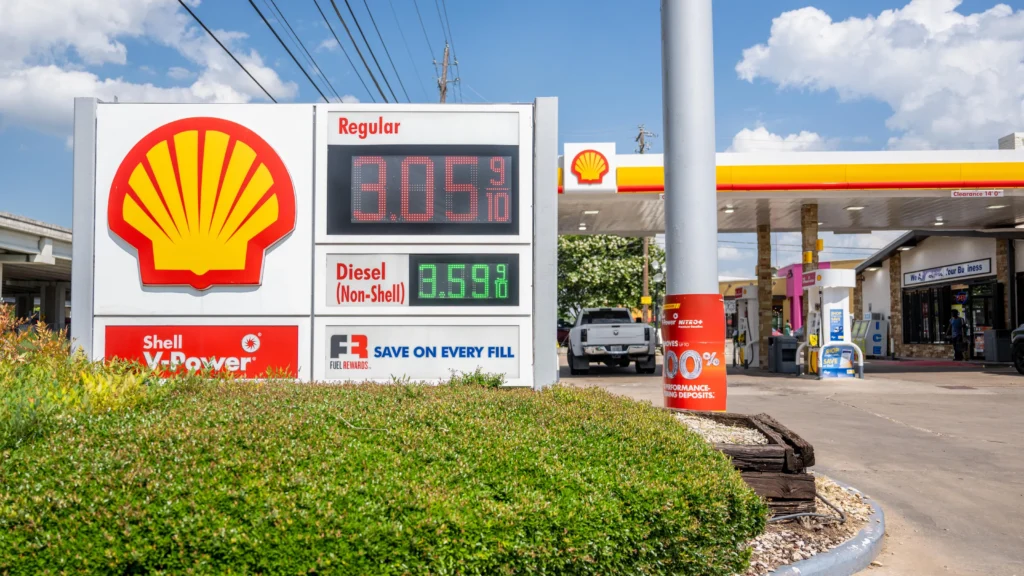Gas prices in the Lower Atlantic region have seen a notable drop, offering some relief to drivers. As of Monday, the average price of regular gasoline in the region was $2.93 per gallon, a decrease from last week’s average of $3.01 per gallon, according to the U.S. Energy Information Administration (EIA).
This decline in prices comes at a time when many drivers are looking to save on fuel costs. The EIA’s latest report highlights the changes in fuel prices, revealing fluctuations that have occurred over the past month, as well as year-over-year price shifts. While gas prices have dropped, they have still experienced some increases compared to this time last month. But overall, the trend remains favorable for drivers in the Lower Atlantic region.
Recent Trends in Gas Prices
The average gas price in the Lower Atlantic region has risen by just 2 cents since last month. This slight increase shows how gas prices have remained fairly stable over the last few weeks. However, when compared to the same time last year, prices have not seen much of a difference. For example, the average price in the region last year was $2.97 per gallon, which is just 1% higher than this year’s price of $2.93.
Throughout 2024, fuel prices in the Lower Atlantic region have fluctuated. Prices ranged from as low as $2.86 per gallon on December 23, 2024, to as high as $3.45 per gallon on May 6, 2024. These fluctuations highlight how factors like seasonal demand, global oil prices, and other regional variables can cause gas prices to rise and fall throughout the year.
Comparing Regional Prices to the National Average
While prices in the Lower Atlantic region have seen a drop, it’s interesting to note how these prices compare to the national average. According to the EIA, the average price of gas across the United States last week was $3.08 per gallon. This means that the Lower Atlantic region is still benefiting from lower fuel prices, with an average price that is approximately 5.0% lower than the national average.
The trend of slightly lower gas prices in the Lower Atlantic region is good news for drivers, especially those who rely on their vehicles for daily commuting or travel. Whether you live in Florida, Georgia, North Carolina, South Carolina, Virginia, or West Virginia, this region continues to see more affordable gas prices compared to other areas in the country.
Gas Prices in the Lower Atlantic Region: A Closer Look
The Lower Atlantic region includes six states—Florida, Georgia, North Carolina, South Carolina, Virginia, and West Virginia. Each of these states has experienced varying changes in gas prices, reflecting local market dynamics, demand for fuel, and supply factors.
Florida: As one of the largest states in the region, Florida often sees significant fluctuations in gas prices due to the high demand for fuel, especially from residents and tourists. The state also has a large number of long-distance travelers, which impacts the price of gasoline.
Georgia: Georgia’s gas prices have generally followed the regional trends, but local factors, including taxes and infrastructure, can affect how prices fluctuate. The state’s economy and the presence of major cities like Atlanta also influence demand and pricing.
North Carolina: North Carolina has faced steady changes in gas prices, largely mirroring trends seen across the rest of the Lower Atlantic region. However, prices in the state can be higher in rural areas where access to fuel supply chains might be more limited.
South Carolina: Gas prices in South Carolina have been closely aligned with regional prices, and the state has seen a more gradual drop in fuel costs over the last several weeks.
Virginia: In Virginia, gas prices often follow the national trend due to the state’s proximity to the political and economic centers of Washington D.C. Local regulations and fuel taxes also play a role in price variations within the state.
West Virginia: As one of the smaller states in the region, West Virginia sees fewer fluctuations in gas prices compared to larger states. However, the state still experiences the same seasonal price shifts, with prices rising during high-demand periods like summer holidays.
Factors Affecting Gas Prices in the Lower Atlantic Region
Several key factors influence the price of gasoline, including global oil prices, local demand, seasonal variations, and even government policies. Here’s a breakdown of some of these key drivers:
1. Global Oil Prices: The global price of oil is one of the most significant factors influencing gas prices. If oil prices rise due to global economic trends, political instability, or other reasons, the cost of producing gasoline increases. This increase is often passed on to consumers, causing gas prices to rise.
2. Local Demand: The demand for gas in a particular region can drive prices up or down. For example, during holiday seasons or peak travel times, the demand for fuel may rise, pushing prices higher. Conversely, during off-peak seasons, prices may fall as demand decreases.
3. Seasonal Changes: Gas prices often rise during the summer months due to increased demand for road trips and travel. Additionally, refineries switch to producing different types of fuel in the summer and winter, which can affect prices. In the winter, lower demand for travel can lead to lower prices.
4. Supply Chain Issues: Local factors such as supply chain disruptions, refinery outages, or natural disasters can lead to temporary spikes in gas prices. These issues can restrict the amount of fuel available in certain areas, forcing gas stations to raise prices to balance supply and demand.
5. Government Policies and Taxes: Local government taxes, such as excise taxes on gasoline, can affect the final price consumers pay at the pump. Additionally, government regulations aimed at reducing carbon emissions or promoting electric vehicles can affect fuel prices by changing the demand for gasoline.
What’s Ahead for Gas Prices in the Lower Atlantic Region?
While the current trend of lower gas prices is certainly welcome, experts predict that prices may continue to fluctuate in the coming months. The summer travel season, coupled with unpredictable changes in the global oil market, could cause prices to rise again. Additionally, supply chain disruptions or natural events like hurricanes could temporarily spike fuel costs.
However, with prices currently below the national average, drivers in the Lower Atlantic region have a reason to feel relieved. The continued monitoring of global oil markets and seasonal trends will likely provide more insight into what to expect for the rest of the year.
How to Save on Gas During Fluctuating Prices
Even as prices continue to fluctuate, there are several ways drivers can save on gas:
- Use Gas Price Apps: Apps like GasBuddy and Gas Guru can help you find the cheapest gas stations in your area. By comparing prices, you can avoid paying too much at the pump.
- Maintain Your Vehicle: Keeping your car well-maintained with regular oil changes and tire checks can help improve fuel efficiency. A well-maintained car uses less gas, saving you money in the long run.
- Drive Efficiently: Avoid aggressive driving, excessive idling, and speeding. These habits waste fuel and increase your overall gas costs. Instead, drive smoothly and maintain a consistent speed.
- Carpool or Use Public Transit: Carpooling with others or using public transportation can significantly reduce your personal fuel consumption. If you’re not using your car every day, consider walking or biking short distances instead.
- Plan Your Trips: Combining errands and planning your trips can help reduce the number of miles you drive. This can help you save on gas by minimizing unnecessary trips.
Conclusion
In conclusion, gas prices in the Lower Atlantic region have fallen slightly, offering a reprieve for drivers. With prices averaging $2.93 per gallon, this decrease reflects both regional trends and larger national shifts. While the prices have dropped from last week, they remain relatively stable compared to last month and last year.
As gas prices continue to fluctuate, it’s important for drivers to stay informed and take steps to minimize their costs. With ongoing attention to global oil markets and regional demand, it will be interesting to see where prices head next. In the meantime, drivers in the Lower Atlantic region can enjoy some savings at the pump as they navigate the changes in the market.
Disclaimer – Our editorial team has thoroughly fact-checked this article to ensure its accuracy and eliminate any potential misinformation. We are dedicated to upholding the highest standards of integrity in our content.





More Stories
Gas Prices Continue to Fall in Lower Atlantic Region: See the Latest Average in Your Area
Gas Prices Continue to Fall in Lower Atlantic Region: See the Latest Average in Your Area
Gas Prices Continue to Fall in Lower Atlantic Region: See the Latest Average in Your Area